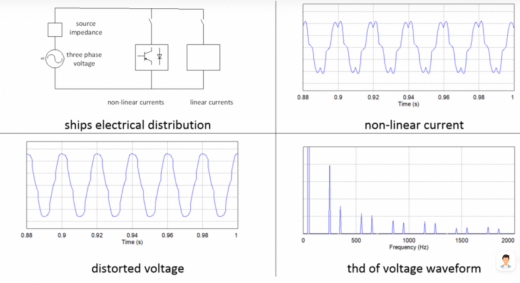Harmonic Distortion
Analysis, calculation, mitigation and verification of harmonic distortion for an extremely reliable power distribution on board, resulting in maximum uptime and optimal operational security.

The quality of the voltages and currents on board ships are important for their AC grids. As a result, classification societies pose restrictions on the Total Harmonic Distortion (THD) permitted on the AC grid voltage.
When we take a look at a classification society like Lloyds, the THD must stay below 8% and the individual harmonic components above the 25th harmonic must stay below 1.5%. With distortion below these limits, the AC grid and all of its components are able to perform in a normal way. With distortion above these limits the distorted AC grid voltage might have a negative influence on the life-time and reliability of the different systems connected to the grid.
What is harmonic distortion?
Voltages and currents on AC grids ideally have a sinusoidal shape, with a base frequency of either 50Hz or 60Hz. Frequency analysis of the wave pattern on the grid shows that it consists of components with a harmonic number times the fundamental frequency. If purity of a sine wave is considered to be ideal, the quality or distorted rate can be defined as the ratio of the distorted signal part and the sinusoidal part. This ratio is called harmonic distortion.
This distortion is created by non-linear currents that are mainly drawn by diode bridges (with or without smoothing chokes). The harmonic components in these non-linear currents lead in their turn to harmonic voltages on the AC grid, caused by the impedance of the supplying source. Much smaller contributions are caused by Active Front End (AFE) converters and the generators supplying the grid.

Our activities
To ensure that the THD stays below 8%, several activities have to be performed within a project. We as a systems integrator are able to perform these activities. These include:
- Analysis
- Calculation
- Mitigation
- Verification
Analysis
At the design stage of a new ship it is essential to analyse the contribution of linear and non-linear loading on the grid for each relevant operational scenario, given the intended design of the power-plant. It is important that the electrical system integrator and the shipyard have a common understanding about the contribution of different systems on board, and a common understanding is needed of the different scenarios in which the electrical distribution system will be used. With these inputs the worst case scenario can be established, in which the THD will reach the highest value.
Calculation
With all the known linear and non-linear loads identified, along with the known impedance of the sources of supply and with the characteristics of the non-linear loads, calculations can be made using an electrical simulation programme. A number of programmes is available for this calculation.
Mitigation
When the calculation shows that the limits posed on the harmonic distortion have been exceeded, the system integrator will adapt the design to meet the required standards. Of course, these measures may have a financial impact, and might also require extra space.
Generally, design alterations are made to consumers, such as:
- To equip one or more power converters with an active front end, instead of a diode bridge.
- To install bigger smoothing chokes for the diode bridges.
- To use (1 or 2) DC grid(s) on board for the heavy loads, supplied by a grid converter with an AFE.
If design alterations are not feasible an alternative approach for this task is to filter out the harmonic components. Passive filters are possible, but nowadays active filters can also be chosen, otherwise known as Active Harmonic Filters (AHF). AHFs are power converters that supply anti- harmonic currents in such a way that harmonic currents are filtered out. For vessels undergoing rebuilds, AHFs can be a particularly attractive option.
Verification
Finally, when acceptance tests are done on the ship, the harmonic distortion is measured. The Classification Society, the shipyard and the electrical integrator have to be sure that the quality of the AC grid voltage is in accordance with the agreed rules and standards. Measurement equipment for the harmonic distortion (THD and all the individual harmonic components) on board vessels is readily available, and can even be installed permanently for continuous monitoring.
Downloads.



